UBIAI
Kudra — AI Data Extraction Platform
Audible Overview Available
Soundbite Case Study
Client
UBIAI
Timeline
Oct 14th 2023 -> Sep 21th 2024
Role
Lead Designer
Strategy
Product Design
Artificial Intelligence
Kudra is an AI data extraction platform the intented design was to make it a platform for effortless extraction of critical data fields, tables, relationships and summaries from documents with a click and transform the data into actionable insights.
Kudra aimed to position itself as a leader in custom data extraction. However, before my intervention, the platform was burdened by a complex and technical outdated interface that alienated potential users, resulting in zero active subscribers and consistently failed every single demo.
The platform lacked immediate value, potential users struggled to grasp the platform's value proposition due to the overly technical setup.
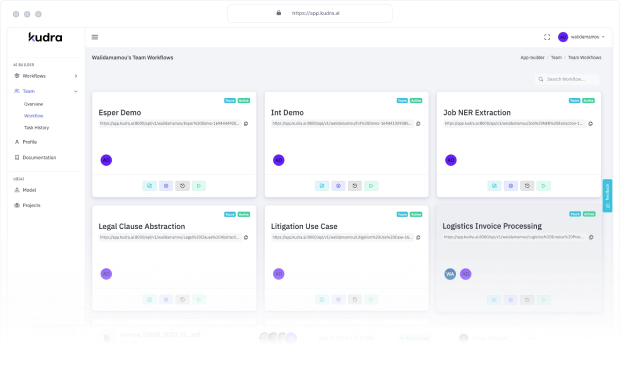
Users found it frustrating to create complex workflows before extracting data. This contradicted their expectation of a simple, AI-powered data extraction process.
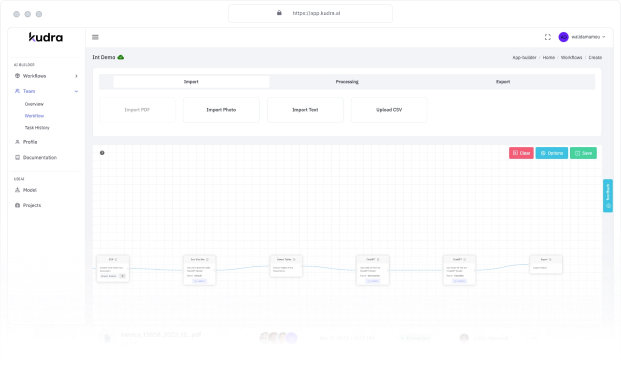
The visual design was antiquated, inconsistent and dominated with dated styles and components that didn’t align with modern user expectations.
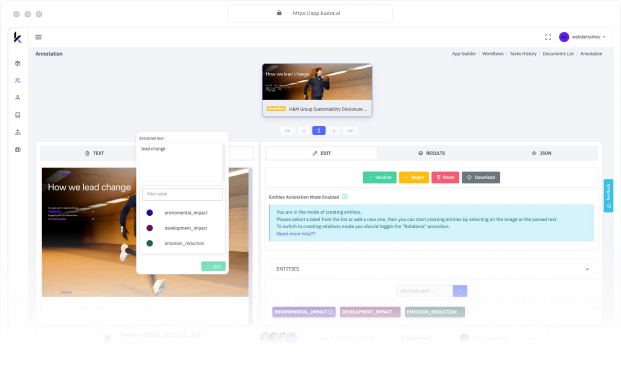
To solve these problems, I used a structured approach to identify user pain points and develop a new product strategy. This strategy focused on making AI-powered data extraction easier while still allowing advanced users to customize their workflows.
Reimagining Product Strategy: Addressing the strategic challenges of the initial MVP.
Redesigned Experience: A comprehensive platform redesign to support the new strategy and ensure we're building a product that addresses user needs effectively.
Redesigned UI: A new look that accomodate for a modern feeling of the platform.
Document-Centric Onboarding: A streamlined experience focused on immediate data extraction.
Pre-built Extraction Templates: Provide Instant access to extraction tools
Intuitive Custom Workflow Builder: Providing advanced features without overwhelming users.
Kudra's promise of AI-powered data extraction wasn't being fulfilled. I focused on simplifying the user experience while preserving its unique features.
Shift the focus to easy, AI-powered data extraction, allowing users to get results quickly without technical setup.
Offer customization as an optional, advanced feature, making it available for those who need it without forcing it on everyone.
Redesign the platform's structure to prioritize fast, easy document extraction while maintaining the flexibility for advanced— or willing to learn —users to customize workflows.
In order to approach my solutions effectively I had to organize my process as the following
Understand
Plan
Craft
Test & Validate
Iterate
I carefully analyzed over 57 demo sessions conducted by our CEO with potential clients who ultimately decided against signing up. These sessions provided a wealth of information, allowing me to closely observe how users interacted with the platform. I focused particularly on identifying friction points during onboarding and pinpointing areas of confusion or frustration.

Through these demos, I discovered two major issues:
✦
Onboarding Issues
Users struggled with the onboarding process, leading to confusion and early abandonment. The platform's requirement for users to configure workflows before extracting data deviated from their expectations of a seamless, AI-powered experience. This created an entry barrier.
✦
Mismatched Expectations
Potential clients expected immediate data extraction from their documents, but instead were faced with a complicated workflow builder that felt more like a developer tool than an AI-powered solution. This ultimately led to to the platform's high rejection rate during demos.
These insights became the foundation for redesigning the onboarding flow and rethinking the overall user experience, ensuring that the platform aligned with users' expectations of a simple, powerful AI tool.
In addition to analyzing demo sessions, we built detailed profiles of our target users to better understand their needs and technical capabilities. Our primary focus was on industries that handle a large volume of documents, such as supply chain management, finance, healthcare, insurance, and human resources. These sectors often require accurate and efficient data extraction from various types of documents, making them ideal candidates for Kudra's AI-powered solution.

Through this profiling process, we identified two key characteristics:
✦
Technical Limitations
Many users lacked technical expertise, making complex workflows and manual configurations difficult to use. They expected a simple, automated process for extracting data.
✦
Diverse Document Types
These industries dealt with many different types of documents, requiring various extraction models. Users needed a solution that could handle this diversity while remaining simple to use.
These insights informed our decision to prioritize a simplified, document-first onboarding flow and the introduction of pre-built extraction templates to ensure users could quickly start extracting data without technical obstacles.
As part of understanding the problems and find an appropriate solution I conducted a competitive analysis of similar data extraction platforms, including Docsumo, Rossum, and Docparser. These platforms catered to industries with heavy document processing needs, making them relevant benchmarks for Kudra’s redesign. By studying their features, onboarding flows, and user feedback, I gained insights into how Kudra could differentiate itself and address gaps in the market.
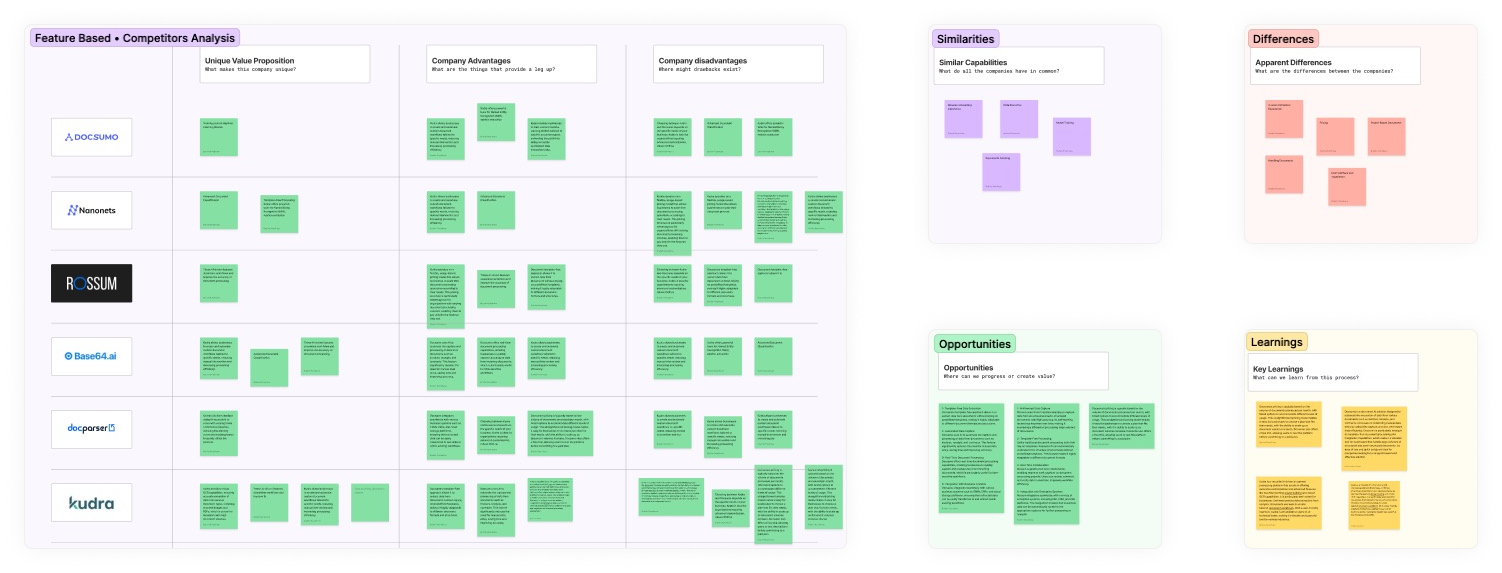
Through this analysis process, I identified three key areas where Kudra could improve to better position itself in the market
✦
Simplified Onboarding and Automation
Competitors like Nanonets offered quick-start onboarding flows, where users could immediately upload documents and begin extracting data without much setup. This highlighted the need for Kudra to shift away from a technical, workflow-first approach to a document-first onboarding experience, ensuring users could extract data quickly and easily.
✦
Pre-built Templates
Platforms like Docparser provided pre-configured templates, allowing users to begin document processing right away without needing to build custom workflows. This reinforced our decision to introduce pre-built extraction templates in Kudra, enabling users to get started immediately while still offering customization options for more advanced users.
✦
Custom Workflow Flexibility
While Kudra’s original workflow builder was too complex for most users, it still provided a level of customization that its competitors don't remotely have, competitive platforms balanced simplicity with customization and this led to a very limited custom extraction. This led me to think reworking Kudra’s workflow builder, making it more intuitive and user-friendly while still offering flexibility for users who needed advanced custom workflows.
This competitive analysis provided invaluable insights into how we could position Kudra as a more accessible, AI-powered platform, focused on ease of use and quick results while retaining advanced capabilities for customization.
After carefully understanding the platform, the problems and what makes us unique it was time to plan out our next steps. The goal was to set a strong strategy to relaunch the product. This meant we had to communicate a lot with developers to address any technical concerns around the redesign, prioritize the redesign aspects and finally have an action plan in motion.
The workshops were designed to bring together cross-functional perspectives to generate innovative ideas and solutions for Kudra’s challenges. Our goal was to reshape the platform into something more user-friendly and aligned with user expectations, while preserving Kudra’s core capability of custom data extraction.
Main Focus
✦
Technical Limitation to the Redesign
✦
Priorities in the Redesign
✦
Pre-requisits of features we're introducing
✦
How to leverage existing features to move quickly
✦
How can we simplify the onboarding experience?
✦
What tools or templates can we offer to minimize setup time?
✦
Keep the flexibility of custom workflows and making them accessible?

We used brainstorming techniques like mind mapping and affinity diagrams to group similar ideas and prioritize them. The sessions fostered creative collaboration especially between design and development, where we explored different approaches to restructuring the platform, including document-first onboarding, pre-built templates, and flexible project setups.
✦
Key Insight
One major outcome of these workshops was the realization that Kudra should focus primarily on document handling and AI-powered extraction rather than positioning itself as a workflow-first platform. This shift was critical because it allowed us to emphasize ease of use while retaining the powerful custom workflows as an advanced feature.
By the end of these workshops, we had a clear direction: Repurpose Kudra as a document-handling platform first, with custom extraction workflows as a secondary, advanced tool. This new narrative would shape the next steps in drafting the strategy and prioritizing the platform's key features.
After prioritizing the core features, we created a user flow that guided users from sign-up to data extraction with minimal complexity. This addressed the problems we identified during the discovery phase and offered advanced customization for those who needed it.
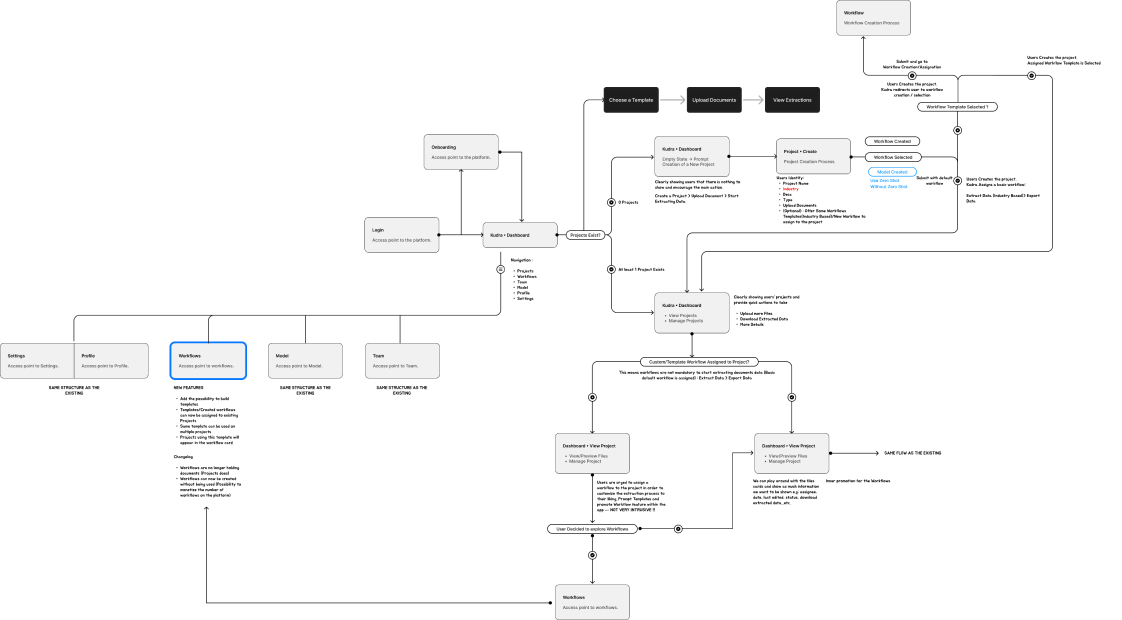
By focusing on streamlining key features, the redesign centered around balancing simplicity for beginners and flexibility for advanced users. From creating Pre-built Templates for instant project setup to enabling more intricate Custom Projects and Workflows, each design decision aimed to reduce complexity while enhancing usability. These improvements ensured that users, regardless of their technical expertise, could leverage Kudra's full potential with ease and efficiency.
Recentering the Kudra around Data Extraction
Making sure Kudra holds up its end of the deal, the main issue I had to solve was to recenter the platform around Data Extraction. To do this making pre-built templates was critical for the success of this strategy.
Extraction Templates
Pre-built templates are the tool that will help transform Kudra into the Ultimate Extraction First tool.
Project Based Extractions
Making data extracted organized helped users find solace and ease of mind especially in extracting documents on multiple rounds.
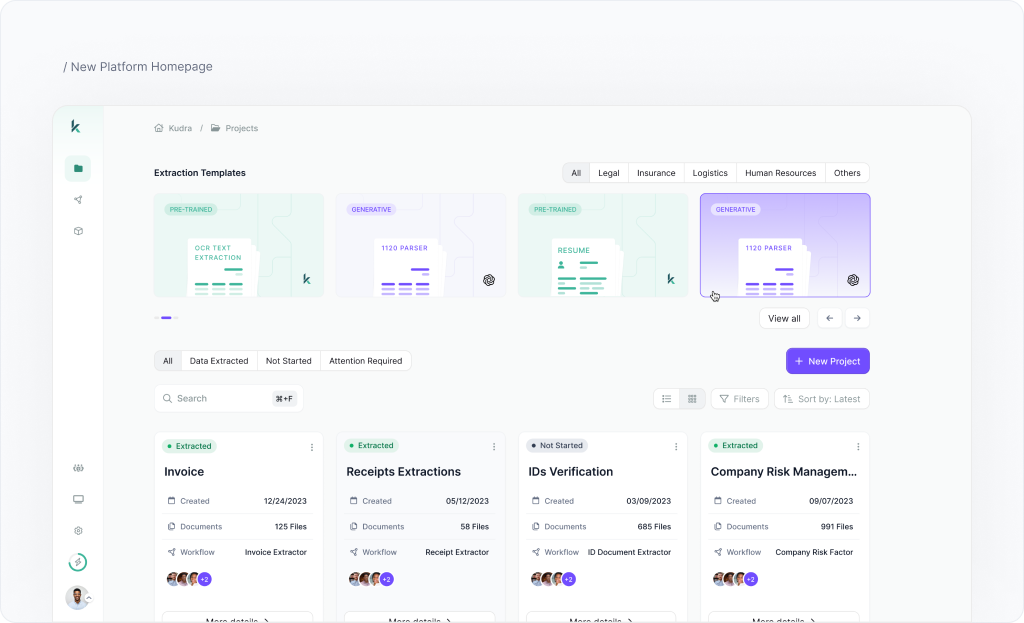
Templates Role
Fundamentally, Templates are Quick Projects — These templates will allow our users to create a documents repository and move straight to upload.

More Details on Hover
We’ve adjusted the Templates cards to hold more information that helps users make the difference between presented templates. And provided more information on hover with a popover detailing what the template does.
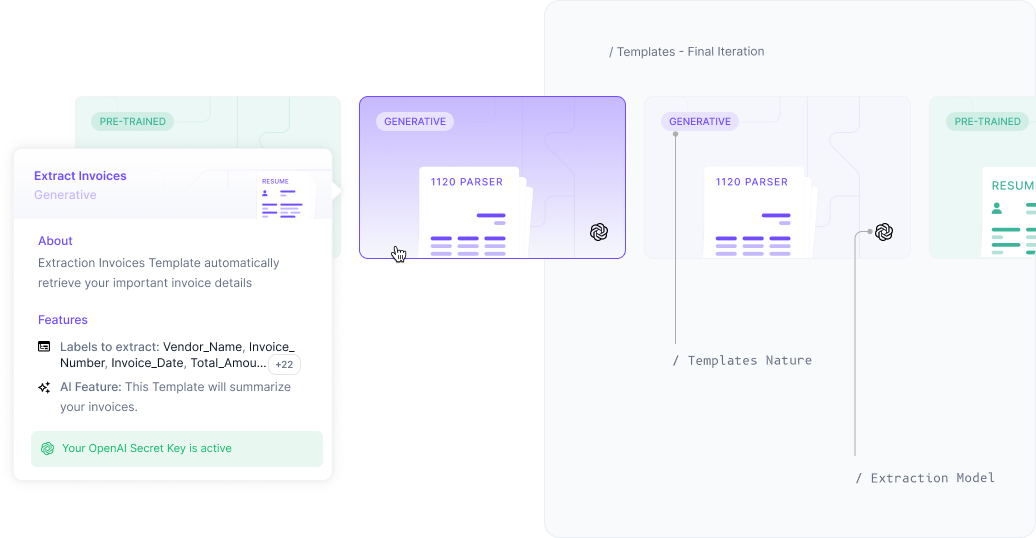
Organized Files and Extractions
To help users save time and effort, creating a project (repository). Lead users to more organized and efficient extractions.
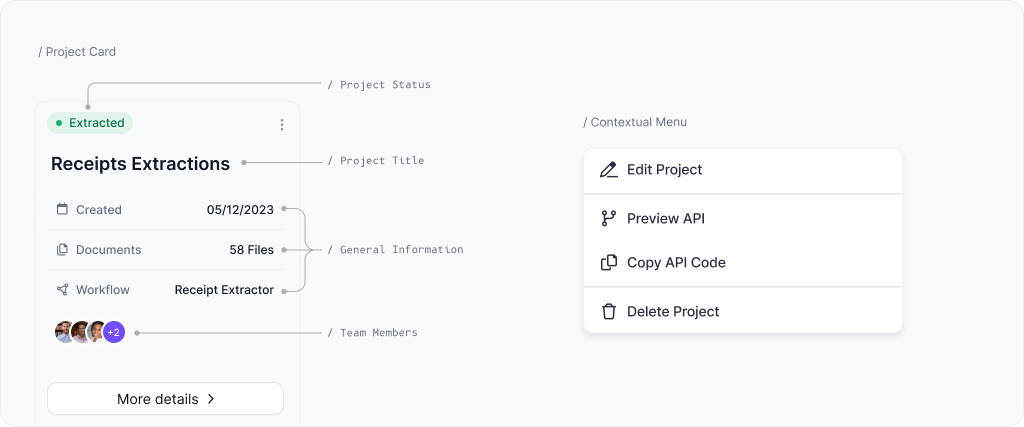
Project Details
Making sure the documents repository (Project) details page contained all relevant information was crucial in building a lean learning curve to start scaling up the users technical knowledge.
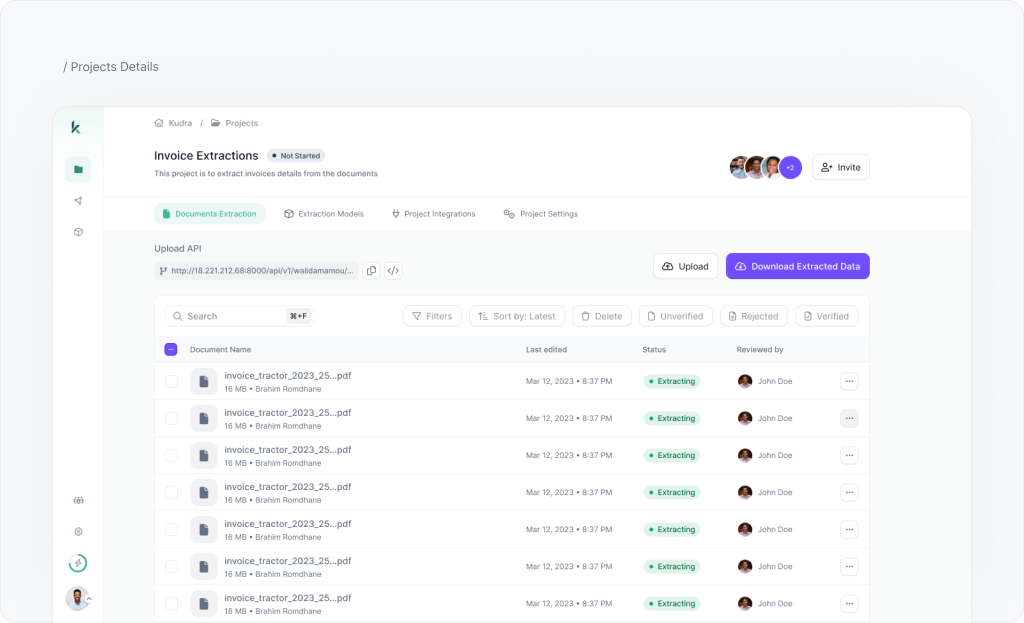
Documents Extractions
Simplified Extractions Results Interface, drawing a line between viewers and editors was important to reduce complications to none technical users.
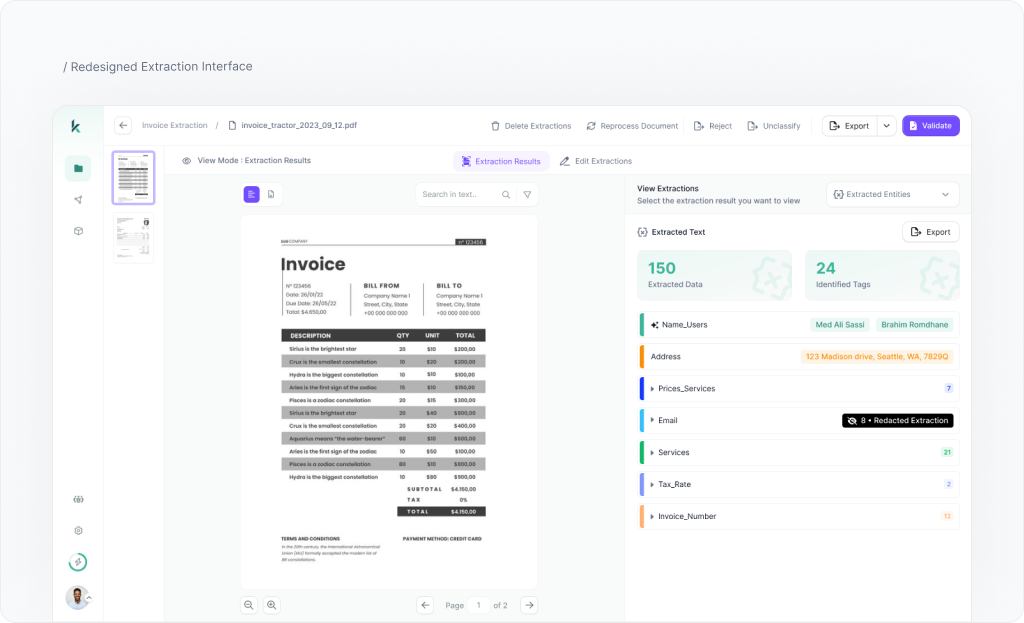
Results Variations
Extraction results can vary in nature or in form, Kudra’s Extraction models can scrap information whether its Entities, Relations, Classifications, Tables and it can even go further and provide an AI summary or an Analysis of the document in question.
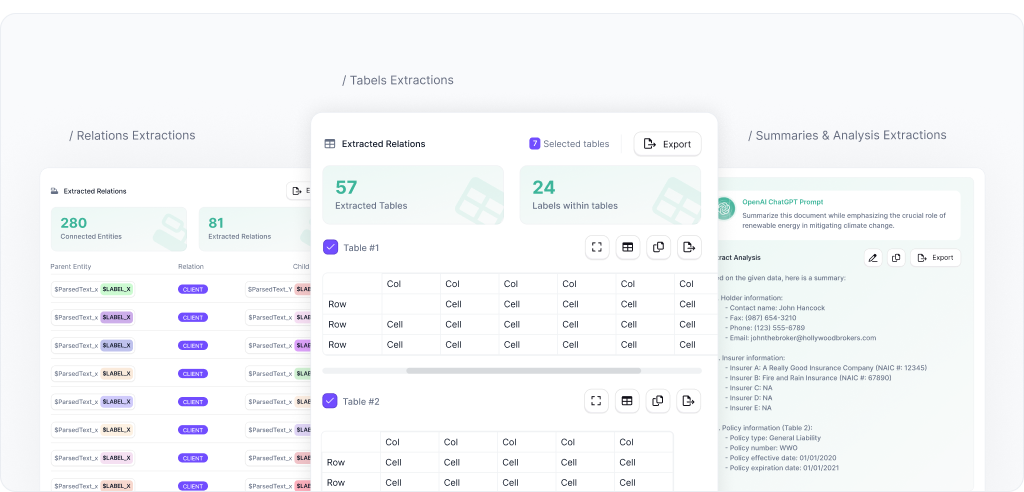
Onboarding
Recentering the platform around fast extraction was the main goal of the product’s overhaul redesign. On that principal we’ve made sure our onboarding is as seamless and as fast for our users to get extracting quickly.
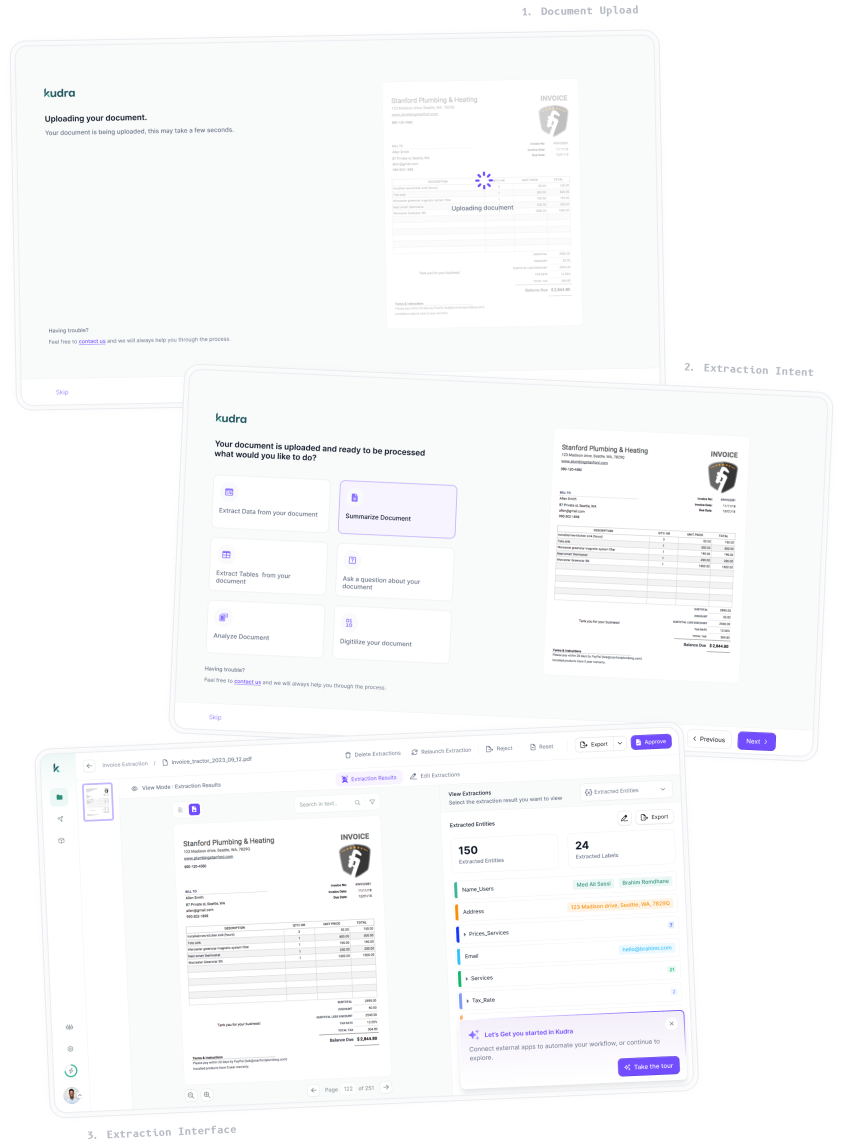
Creating a Project
The first step in giving our users an entry level of technical customization of their data extractions. The Project Creation flow is divided into 3 Sections helping our users in their customization— where they can adjust the data to be extracted, the model used to extract data and the file uploads.
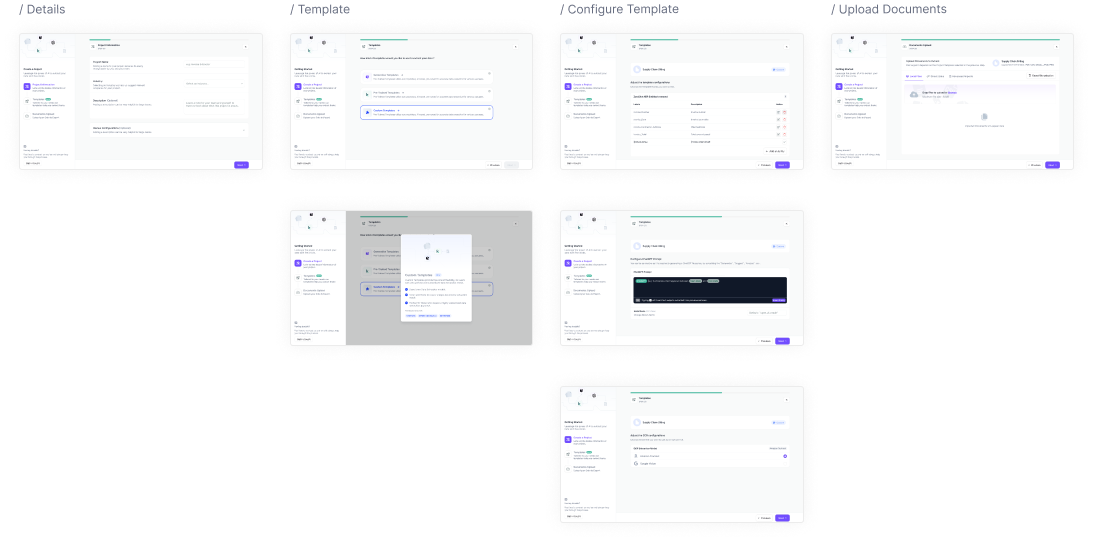
Workflows
Workflows are a powerful tool that allow users to automate and customize their data extraction process.
Workflow Templates
Workflow templates offer pre-configured setups that simplify the data extraction process, allowing users to get started quickly without the need for extensive customization. These templates are designed to handle common use cases, providing an easy-to-use framework for document processing. By using workflow templates, users can save time, reduce errors, and ensure consistency across projects, while still having the flexibility to adjust the template as needed for more specific requirements.
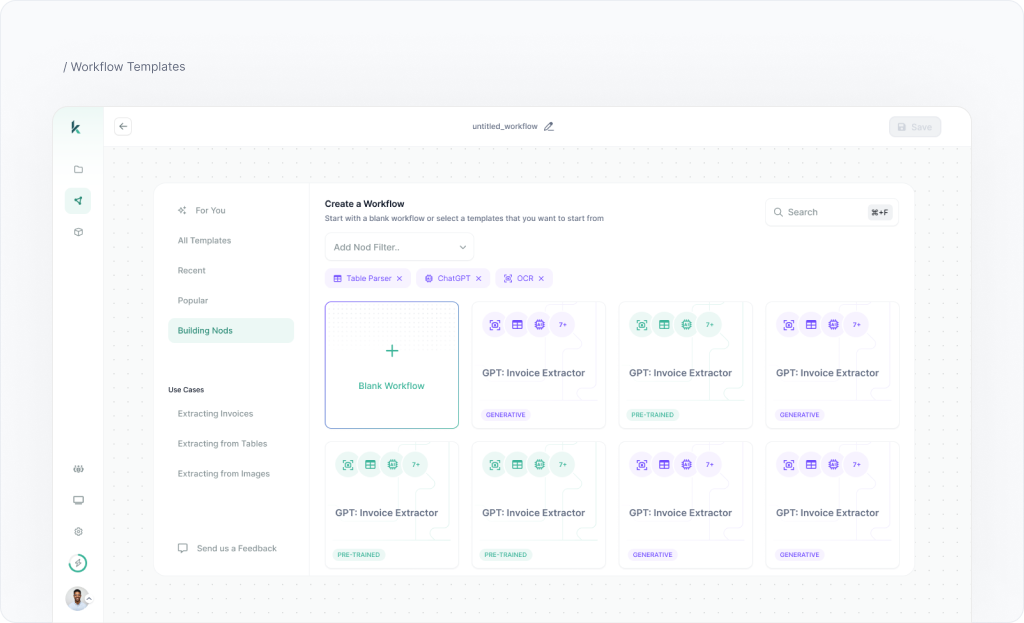
Workflow Builder
By defining a sequence of steps, workflows streamline complex tasks, making it easy to handle large volumes of documents efficiently. Whether using predefined templates or creating custom flows, users can tailor workflows to meet their specific needs, enhancing productivity and reducing manual effort.
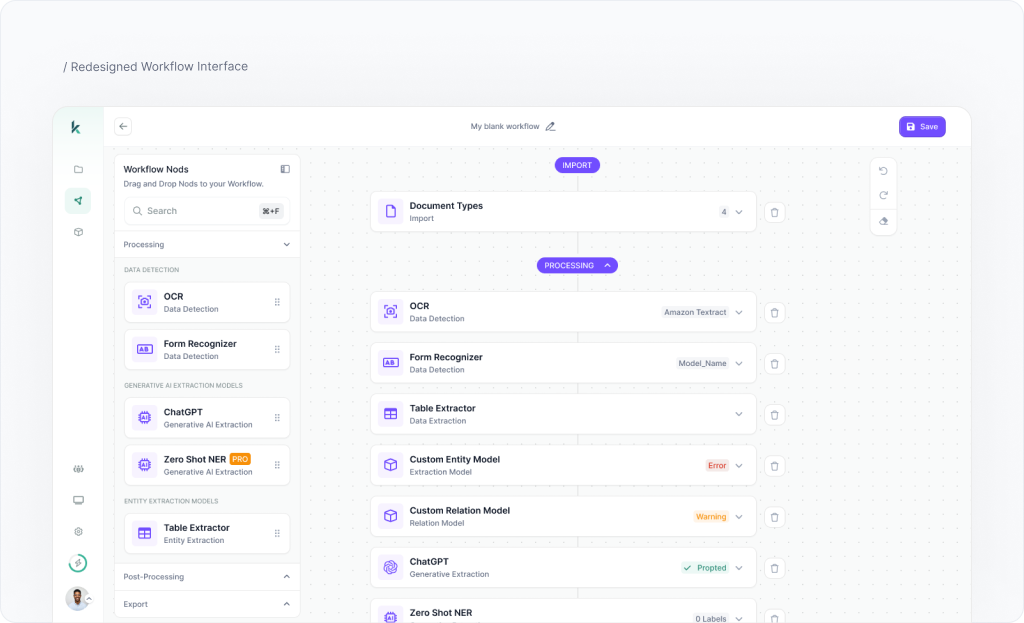
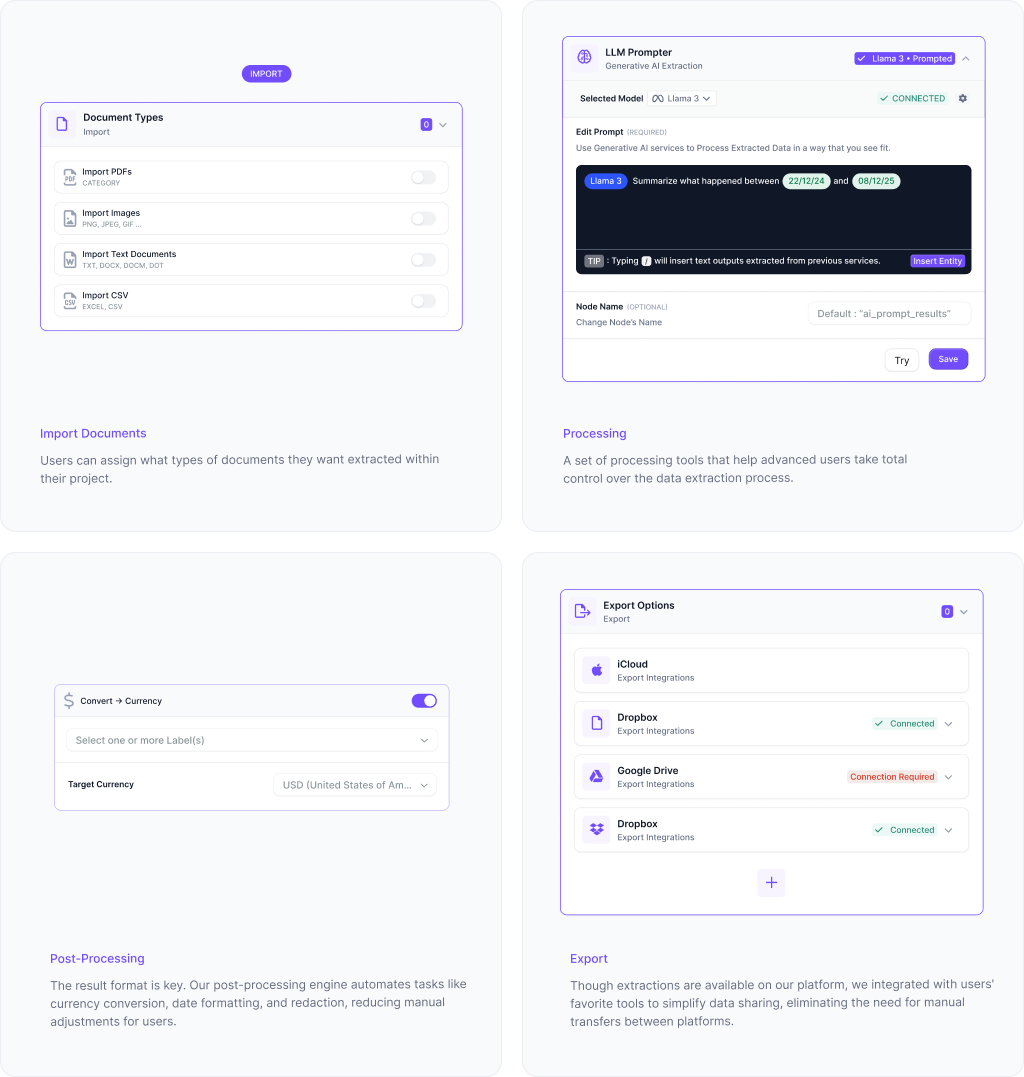
Model Training
The Model Training Feature in Kudra allows users to leverage the refinements they make during the data extraction process to continuously improve the performance of the AI extraction models. This feature is designed to make the models more adaptable to specific user needs and document types, using real-world feedback from users to fine-tune their behavior.
Model Ready to Train
Based on the collected refinement data, Kudra fine-tunes the extraction model to better align with the user’s specific document structure and extraction needs. To ensure meaningful improvements, users must validate at least 30 document extractions before the model can be trained. This threshold ensures the system has enough data to accurately adapt, improving the model's accuracy for handling similar cases more effectively in the future.
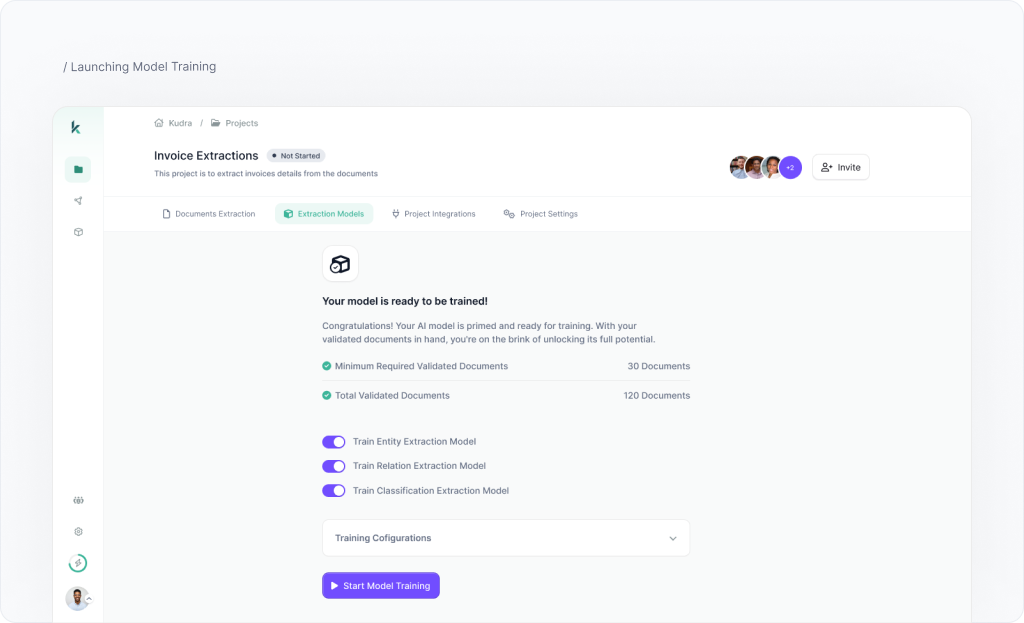
Model Details
Once the model is trained, users can find a digestible breakdown of its performance in the model details. I purposefully introduced an extraction performance score in the interface to help non-technical users better understand the efficiency of their model. This simplifies the experience, allowing them to focus on a clear performance metric rather than relying solely on more complex ones like recall, precision, and accuracy.
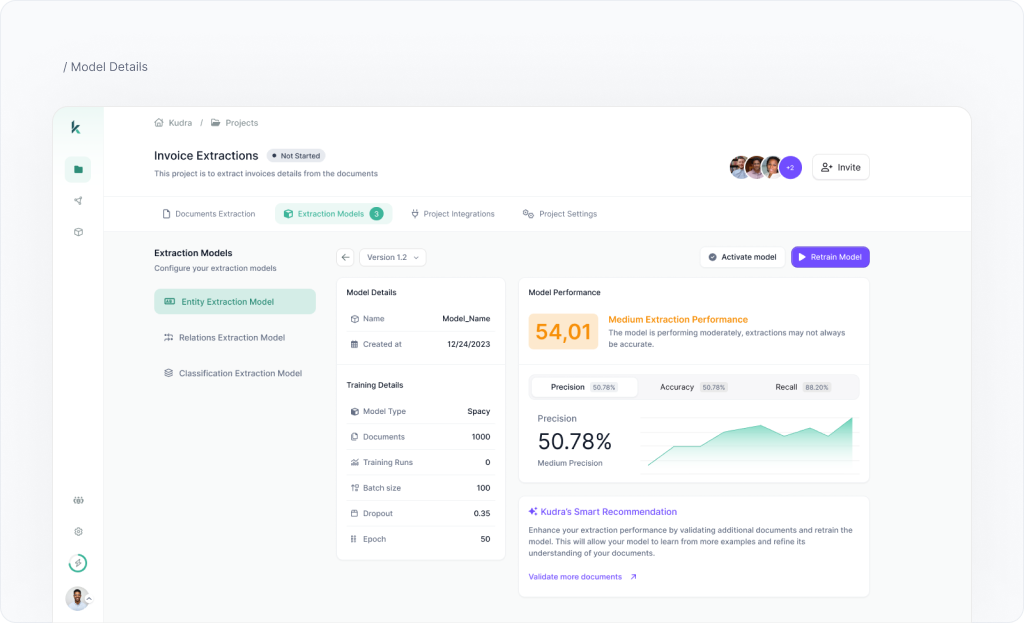
The redesign and strategic approach to Kudra have led us to achieve a promising product-market fit, as evidenced by the following outcomes
Successful Launch
20 Initial Subscribers
We launched on Appsumo to attract early subscribers and gather feedback, resulting in our first 30 AppSumo subscribers
Valuable Insights
3.5 Rating on AppSumo
Positive feedback from users allowed us to iterate on features, enhancing user experience and shaping our product roadmap
Expanding User Base
52 Active Users
We now have 52 active users, with a consistent monthly conversion rate of around 22% from our landing pages.
High Adoption Rates
60% Adoption Rate
We achieved a 43% adoption rate from Appsumo subscriptions and an impressive 60% adoption rate from users acquired through other channels.
Learnings
Designing and restructuring Kudra has been a profound learning experience, especially when it came to abstracting highly technical systems for users with varying degrees of expertise.
The most significant lesson I learned was how to transform a technically complex solution into a digestible, user-centric product. Kudra started as a platform that expected users to understand and build custom workflows, which proved overwhelming and led to frustration.
This experience also highlighted the importance of prioritization. Introducing pre-built templates was a quick win that immediately addressed the users' pain points, but I also worked on long-term solutions like rethinking the onboarding process and building a more robust project system to create flexibility for more complex use cases. The balance between these helped drive early adoption while ensuring long-term scalability.
From the initial low-fidelity designs to the high-fidelity product, constant user feedback allowed me to refine the solution and ensure it solved real problems in a meaningful way. This iterative approach helped build a product that users found easy to understand and adopt.

